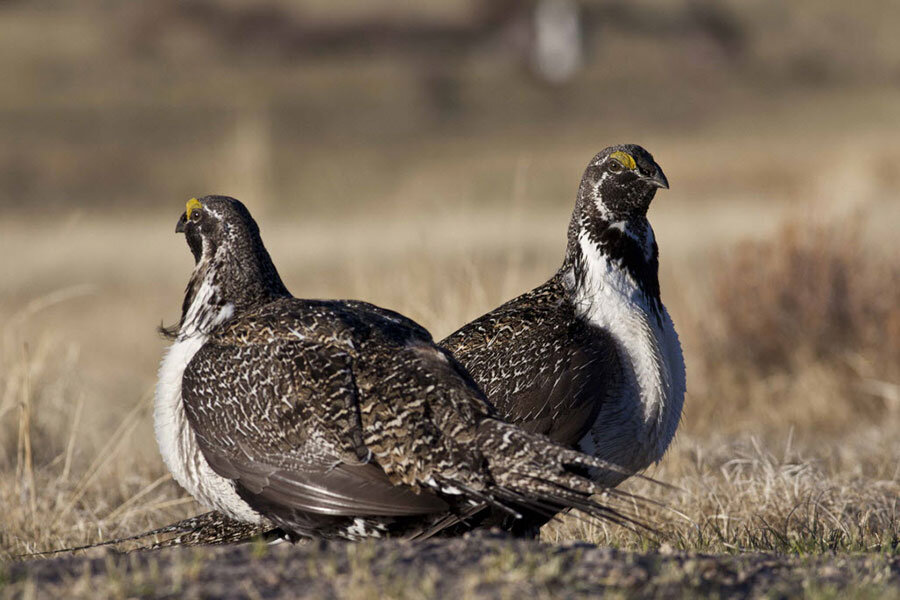In Western sagebrush, a new model for saving threatened species
Loading...
| Boulder, Colo.
One of the most iconic species of the West – the greater sage grouse, known for its distinctive mating dance – is fast disappearing, as is the sagebrush habitat that supports it.
But the battle to protect both the bird and the “Sagebrush Sea” – millions of acres of grasslands across 10 states – is taking shape as a nationally significant effort that could offer a new and more collaborative template for saving threatened species.
The plans put forward by the United States Department of the Interior last week speak to compromise and flexibility on a groundbreaking scale. In all, there are 14 plans tailored specifically to different regions. They identify habitat deemed essential for the species’ survival and lay out how to minimize disturbances in those zones – from restricting energy development to reducing wildfire threats and invasive species.
The effort brings together groups that typically are at one another’s throats, from federal agencies to conservationists to governors to landowners. And it uses the Endangered Species Act as a stick: If these groups don’t come together and act on their own, the sage grouse could be listed by Sept. 30, and that would bring in the federal government in a much more restrictive way.
Some conservationists say the deal doesn’t go far enough, creating a messy patchwork of uneven solutions. Energy interests say it could affect 18,000 jobs. But if the plans are successful in avoiding a listing, it could mean that more attention is given to conservation instead of the usual turf battles sparked by the Endangered Species Act, others say.
“You’d have more parties working together for a solution as opposed to putting on their gladiator outfits and spending money on lawyers instead of on conservation,” says David Hayes, a visiting senior fellow at the Center for American Progress who served as deputy secretary of the Interior under Presidents Obama and Clinton. “The ESA is just a juicy political football in the West, and is irresistible for some parties to engage in rhetoric around it, and that’s not productive.”
The idea of flexible, locally tailored conservation plans that bring together a broad range of often-conflicting interests is not new. A few years ago, landowners and oil and gas operators in New Mexico and Texas got together to create voluntary conservation measures to save the dunes sagebrush lizard, says Mr. Hayes. But the sage grouse efforts are on a much larger scale.
“What unique about the sage grouse [plan] is the scale of the effort. You’re talking about tens of millions of acres,” he says.
The grouse, which once numbered in the millions, have been reduced to a population of about 200,000, according to most estimates. And the federal government must make a decision about whether to list the bird as an endangered species by the end of September.
The fact that most of the key sage grouse territory is managed by the federal Bureau of Land Management (BLM) – historically not known for its sympathy to conservation efforts – makes the agency’s part in the plans noteworthy.
Westerners “want a balanced approach that takes into consideration all the different interests that use this land,” says Chris Saeger, director of the Western Values Project. “What we saw is something that comes very close to that ideal.”
In announcing the plans last week, Interior Secretary Sally Jewell emphasized the importance of the sagebrush habitat not just for the sage grouse but to the Western economy as an iconic element of the Western landscape. It’s a habitat home to some 350 species – including mule deer, pronghorn antelope, and golden eagles – and is key for recreation industries.
“Together with conservation efforts from states and private landowners, we are laying an important foundation to save the disappearing sagebrush landscape of the American West,” she said.
For some conservationists, there are questions about whether the plans will work.
“There are huge inconsistencies between sage grouse plans from state to state,” says Erik Molvar, the Sagebrush Sea campaign manager for Wildearth Guardians. “It appears that the Wyoming protections are so weak that by themselves they would lead to the conclusion that ESA [Endangered Species Act] protections are necessary.”
The energy lobby, on the other hand, says the plans are too restrictive.
Saving the sage grouse is a goal “best achieved at the state level, not with a one-size-fits-all federal approach,” said Kathleen Sgamma, vice president of government and public affairs at Western Energy Alliance, a trade group representing oil and gas companies, in a statement. The restrictions, she said, could affect between 9,170 and 18,250 jobs.
But tradeoffs are a part of any deal, others say. The energy industry will have some areas closed to drilling, but 90 percent of oil and gas interests of high or medium potential are outside of high-priority areas for protection, says Nada Culver, a senior director at The Wilderness Society.
“There’s a lot of things being addressed through this plan that benefit pretty much everybody,” she says. “The ‘burden’ seems to be pretty minor for what you’re getting. Is it enough? I’m still looking at that.”
The parties involved might have found a “sweet spot,” says one county commissioner in Colorado.
“The two key words here are certainty and balance,” says Tim Corrigan of Routt County. “My friends in the environmental community are less than satisfied, and people in the development community are less than satisfied, and that means the BLM may have found a sweet spot here.”






